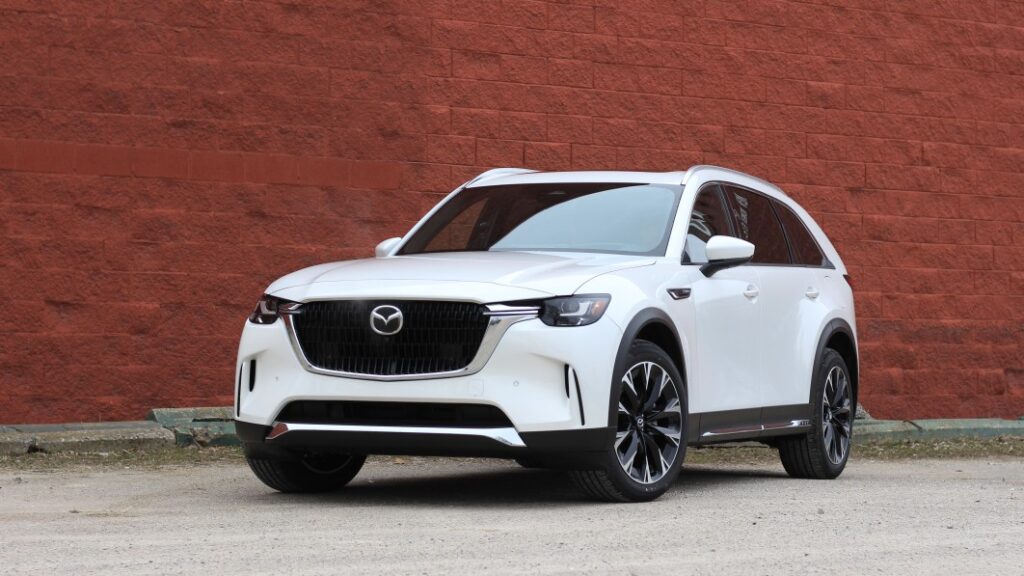2024 Mazda CX-90 PHEV Long Term Intro: We plug-in to a year with Mazda's flagship

Our long-term test garage was suddenly devoid of efficiency and practicality after the departures of our all-electric Kia EV6 and hybrid Toyota Sienna. So, we looked for practical, green machinery that’s recently been introduced, and one of our top choices was available: the 2024 Mazda CX-90 Plug-In Hybrid. Not only does it give us something with three rows and cargo space again, but it’s also a big vehicle for Mazda, figuratively and literally.
The CX-90 is the first model in the United States to use Mazda’s new rear-wheel-drive-based platform (with the shorter CX-60 offered overseas). It’s the first time since the early 1990s that Mazda has used a rear-drive-based platform in anything other than its sports cars. Not only that, it features new powertrains. On the base and top-level models are different versions of a turbocharged straight-six, and floating in the middle are plug-in hybrid models. Mazda’s first plug-in hybrid powertrain in the U.S. combines the familiar naturally aspirated 2.5-liter four-cylinder with an electric motor between the engine and its eight-speed automatic transmission (another new component for Mazda). Total output for the hybrid is 323 horsepower and 369 pound-feet of torque. Not only does that make it Mazda’s second most powerful production car (behind only the high-output six-cylinder CX-90), but its 17.8 kilowatt-hour battery pack allows it to go an EPA-estimated 26 miles on electricity alone.
This new platform has impressed us on a dynamic level, at least in the short term, though we’ve also noted that it might not be as spacious as we’d hoped. So we have a lot we want to learn about this big Mazda, including how efficient and useful it will be, as well as whether we’ll still like driving it as the calendar turns over.



Why we got it
As we already mentioned, we want to get more seat time behind the only other rear-drive-based vehicle Mazda has to offer here besides the Miata (and yes, there’s the CX-70, but that’s just a two-row CX-90). And we opted for the plug-in hybrid, not only to have something a little greener in our fleet, but because this is the most electrified Mazda since the ill-fated (and ill-conceived) MX-30 EV. We want to know if this plug-in hybrid manages to be genuinely efficient and worth owning. We also want to see if this gas-electric combination continues to drive well in the long haul and if it stays reliable. We know the gas engine on its own is a tried-and-true unit, but there’s a lot of complexity added to it with the electric motor and new transmission. Such powertrains have proved troublesome for other automakers.
We want to get a feel for this vehicle’s usefulness as well. In our luggage test, it proved to have less space behind the third row than rivals from mainstream brands, but sized up well against luxury options.
And to that end, we’d like to see if this really is an upmarket competitor, as Mazda wants it to be. The brand has made it very clear it wants to become more of a luxury player, more in the vein of something like Acura. Adding a traditional rear-drive platform with longitudinal powertrains to the company’s already upscale interior seems like a strong move in that direction, but will life with it bear that out?



What we got
We opted for the Premium Plus trim, which will let us experience absolutely everything the CX-90 PHEV has to offer. This top-level trim comes with a variety of features not offered on the other PHEVs including a windshield wiper de-icer, power-folding side mirrors with auto-dimming on the driver side, Nappa leather upholstery, heated and ventilated front seats, heated second-row seats, heated steering wheel, rear window shades, a 12.3-inch infotainment touchscreen display (versus the standard 10.25-inch screen that does not offer touch control), an extra 150-watt power outlet (in addition to a 12-volt power socket and a 1,500-watt power outlet) and a 360-degree camera system. This is in addition to other features shared with lower trims including 21-inch wheels, power liftgate, three-zone automatic climate control, the aforementioned 1,500-watt power outlet, Bose sound system, wireless phone mirroring and charging, head-up display, adaptive cruise control, lane-keep assist, blind-spot warning and rear cross-traffic alert.
Being the top-spec PHEV, the only options were color choices. Ours is painted in Rhodium White Premium, which is an extra $595. Inside, it has the black leather option, and it features brown accents and contrast stitching. With the $1,375 destination charge, our CX-90 came to a total of $59,420. That’s just shy of $10,000 higher than a base CX-90 PHEV.
Look for new updates on Fridays, along with those for our long-term Subaru WRX as we get settled in with the big Mazda.
Related video:



